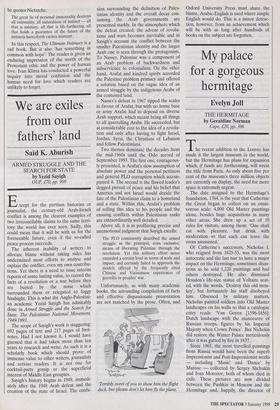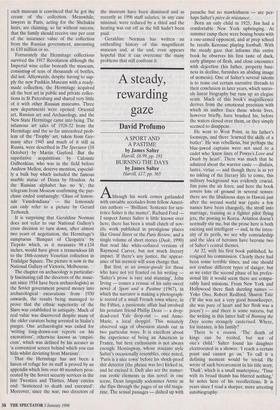My palace for a gorgeous hermitage
Evelyn Joll
THE HERMITAGE by Geraldine Norman Cape, f20, pp. 386 The recent addition to the Louvre has made it the largest museum in the world, but the Hermitage has plans for expansion which, if funds are forthcoming, will wrest the title from Paris. As only about five per cent of the museum's three million objects are currently on display, the need for more space is extremely urgent.
The date assigned to the Hermitage's foundation, 1764, is the year that Catherine the Great began to collect on an omni- vorous scale: 4,000 Old Master paintings alone, besides huge acquisitions in many other areas. She drew up a set of 10 rules for visitors, among them: 'One shall eat with pleasure, but drink with moderation so that each can leave the room unassisted.'
Of Catherine's successors, Nicholas I, who reigned from 1825-55, was the most autocratic and the last tsar to have a major impact on the Hermitage, sometimes disas- trous as he sold 1,220 paintings and had others destroyed. He also dismissed Houdon's life-size statue of Voltaire seat- ed, with the words, 'Destroy this old mon- key', but fortunately his staff disobeyed him. Obsessed by military matters, Nicholas painted soldiers into Old Master landscapes on his walls so that a catalogue entry reads: 'Van Goyen [1596-1656]: Dutch landscape with the manoeuvre of Russian troops, figures by his Imperial Majesty when Crown Prince'. But Nicholas did restore the Winter Palace meticulously after it was gutted by fire in 1837.
Since 1965, the most travelled paintings from Russia would have been the superb Impressionist and Post-Impressionist works — including 'Music' and 'Dance' by Matisse — collected by Sergey Shchukin and Ivan Morozov, both of whom died in exile. These pictures are now divided between the Pushkin in Moscow and the Hermitage and, happily, the director of each museum is convinced that he got the cream of the collection. Meanwhile, lawyers in Paris, acting for the Shchukin heirs, are claiming, so far without success, that the family should receive one per cent of the insurance value of the collection from the Russian government, amounting to £10 million or so.
Fortunately the Hermitage collections survived the 1917 Revolution although the Imperial wine cellar beneath the museum, consisting of tens of thousands of bottles, did not. Afterwards, despite having' to sup- ply the new Pushkin Museum with a ready- made collection, the Hermitage acquired all the best art in public and private collec- tions in St Petersburg and shared very little of it with other Russian museums. Three new departments were opened: Oriental art, Russian art and Archaeology, and the New State Hermitage came into being. The infamous art sales of 1928-32 from the Hermitage and the so far unresolved prob- lem of the 'Trophy' art, taken from Ger- many after 1945 and much of it still in Russia, were described in The Spectator (18 October) by Martin Gayford. But the superlative acquisitions by Calouste Gulbenkian, who was in the field before Andrew Mellon, deserve mention, especial- ly a bulk buy which included the famous marble statue of Diana by Houdon. As the Russian alphabet has no 'h', the telegram from Moscow confirming the pur- chase ended confusingly: 'Glass of lemon- ade Vamdondiana' — the lemonade can only refer to a picture by Gerard Terborch.
It is surprising that Geraldine Norman does not refer to our National Gallery's crass decision to turn down, after almost two years of negotiation, the Hermitage's sumptuous 'Banquet of Cleopatra' by Tiepolo which, as it measures 98 x 134 inches, would have given a tremendous lift to the 18th-century Venetian collection in Trafalgar Square. The picture is now in the National Gallery of Victoria, Melbourne.
The chapter on archaeology is particular- ly fascinating (all the directors of the muse- um since 1934 have been archaeologists) as the Soviet government poured money into archaeological excavations from 1930 onwards, the results being massaged to prove that the ethnic superiority of the Slays was established in antiquity. Much of real value was discovered despite many of the older curators being arrested in Stalin's purges. One archaeologist was exiled for `writing long-drawn-out reports on his excavations', otherwise known as 'empiri- cism', which was defined by his accuser as `a convenient screen behind which you can hide whilst deviating from Marxism'.
That the Hermitage has not been a haven of refuge for its staff is proved by an appendix which lists over 40 members pros- ecuted by the Soviet security services in the late Twenties and Thirties. Many entries end: 'Sentenced to death and executed'. Moreover, since the war, two directors of the museum have been dismissed and as recently as 1996 staff salaries, in any case minimal, were reduced by a third and the heating was cut off as the bill hadn't been paid.
Geraldine Norman has written an enthralling history of this magnificent museum and, at the end, even appears hopeful that it can overcome the many problems that still confront it.



















































 Previous page
Previous page